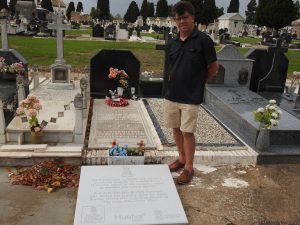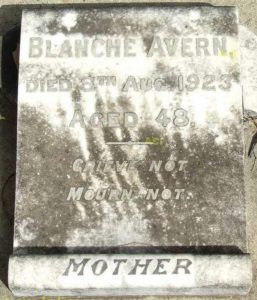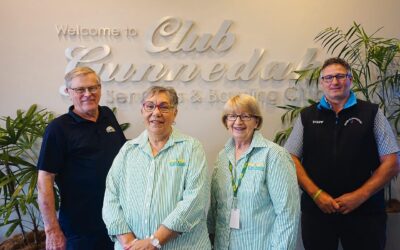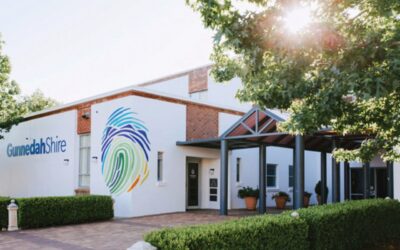Eighteen months ago, the Gunnedah Times reported on the ceremony at the British Cemetery in Huelva to honour two allied airmen who were killed when their Beaufighter crashed near Gibraleón on the April 19, 1942.
The Australian pilot, Sergeant Geoffrey Avern, was born in Gunnedah and his mother Blanche Avern is buried in the Curlewis Cemetery.
Along with English navigator Sergeant Philip Crossan, Geoffrey Avern was flying the plane from Cornwall to Gibraltar.
When organiser Chris Wright discovered that Geoffrey Avern was born in Gunnedah, he contacted the historical society which resulted in the Gunnedah Times featuring the story on its front page.
“Subsequently a member of Geoffrey Avern’s family made contact and said that his own father’s hope was that someone from the family visited the grave,” Chris said in an email to the Gunnedah Times.
Now 81 years after that fateful day, Geoff Button made the pilgrimage to pay his and the family’s respects to Geoffrey Avern and Philip Crossan, thus closing a chapter in the family’s history.
Geoff Button’s great aunt, Hazel Carter, was the second wife of Geoffrey Avern’s father, Henry, after the death of Blanche Avern.
“So I’m not a blood relation, but Henry Avern, known to us as Uncle Hal, was a significant figure in my own father’s life, especially as his own father had died when he was still a child,” Geoff Button said.
“Geoffrey Avern was talked about for as long as I can remember as someone held in high esteem, even though he died when my father was only eight years old.”
Geoff Button was full of praise for the group who last year organised the special ceremony, which has resulted in the local authority together with the Bishop of Madrid drawing up plans for the renovation of the site.
The British Cemetery, adjoining the Catholic Cemetery where ‘The Man Who Never Was’ (WWII Operation Mincemeat) is buried, was overgrown and had sadly been neglected until a group of Tavira residents set to work to enable the ceremony to take place on April 19 last year, marking the 80th anniversary of the crash. High ranking military personnel from the Australian and British embassies attended the event.

Geoff Button also paid his respects at the grave of ‘The Man Who Never Was’ in the Catholic Cemetery.
“Gladys Méndez Naylor, the daughter of Dona Isabel Naylor de Mendez who for many years tended the graves and was awarded an MBE by Queen Elizabeth II, has been instrumental in co-ordinating the local interest and recently had a meeting on site with the archaeologist and architect responsible for the work,” Chris Wright said.
“There are more than a hundred graves in the British Cemetery, many of them relating to former workers at the Minas de Riotinto north of Huelva. Three of the graves are of the wife and two young children of Dr William Mackay from Caithness in Scotland, who was in charge of the welfare of the miners and their families. In addition, William tended to the local poor for free on Thursdays.”
William Mackay was named an adopted son of the city of Huelva in 1923, and the street he lived in was named after him. On receiving this honour, he said: “The greatest sadness of my life I have suffered in Huelva, and here I have enjoyed the greatest happiness, too”.
“As one Australian family can finally honour a lost son, they can further reflect that his final resting place will be a fitting tribute where he and many others can rest in peace,” Chris Wright said.
Background: Geoffrey Avern was born in Gunnedah on April 27, 1914, the son of Henry and Blanche Avern, who had arrived in Australia with their three older children Edward, Raymond and Winifred.

Blanche Avern’s headstone at Curlewis. Blanche was the mother of Sergeant Geoffrey Avern.
Henry Avern was an Insurance Inspector for a number of years and when Blanche Avern died in 1923, she was buried at Curlewis Cemetery. Henry married Hazel Carter, at Scone, the same year.
Geoffrey Avern qualified as a teacher in 1932 before enlisting in the Royal Australian Air Force. After completing his military training, he saw service in South Africa before being promoted to Sergeant and joining the 236th Beaufighter Squadron at Wattisham, near Ipswich, Suffolk, some 10,000 miles from his home in Australia.
On the morning of that fateful day, their Bristol Beaufighter Mk. VIc, with registration T4936 belonging to 236th Squadron of the Royal Air Force, took off from RAF Trebeluze (St Mawgan, Cornwall) bound for the Middle East with a stopover in Gibraltar.
Chris Wright’s research had revealed that the plane lost control, possibly being shot down by Spanish anti-aircraft batteries, as eyewitnesses described seeing flames coming from it as it flew over Olonta before crashing seconds later.
The other crew member, Philip Bernard Crossan was the son of Bernard and Elsie Margaret Crossan, of Borough Road, Middlesbrough, Yorkshire.
Mr Wright said it is easy to walk past the bullet-scarred exterior of the gates and walls on entering or leaving the British cemetery, without recognising them as tangible and moving evidence of Huelva province’s involvement in the Spanish Civil War.
To order photos from this page click here




